he
Machiguenga (also known as the Machigenga, Matsiguenka, Matsigenka or
Matsigenga) language belongs to the Campa group of Arawakan (Maipurean) language
family. At one time, the Arawakan group of languages was spoken widely
across the Americas. In fact, the first native Americans that Christopher
Columbus encountered spoke Taino, an Arawakan language from the Caribbean.
Currently in the Peruvian Amazon, approximately 12,000 people speak the various
Machiguenga dialects. There are two main dialects of Machiguenga, Machiguenga
proper and Nomatsigenga. Other languages in the Campa linguistic group
include Asháninka and Caquinte, which are distinctly different languages from
Machiguenga.
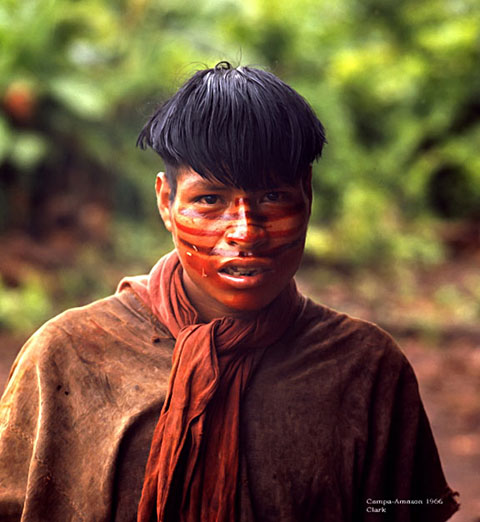 The
Machiguenga are indigenous to the jungles of Southeastern Peru and the border region
of Peru with Bolivia and Brazil. Along with much of South America, their culture
was severely put under strain by the arrival of the Europeans. The Inca
Empire was located immediately to the west of the Machiguengas and when the
nearby Incas were defeated by the Spanish, some of the refugees fled to the
jungles inhabited by the Machiguengas and other Campas and most probably became
assimilated into these Amazonian cultures. Until the 1960's, most of the
Machiguenga lived isolated from Westerners due to their remote locations.
This changed when the Summer Institute of Linguistics (SIL) began flying in
American missionaries with small aircraft in the 1960's. However, due to the
impenetrable Amazon rainforest, some small groups of uncontacted Machiguengas
have survived to this day and remain living in voluntary isolation from Western
civilization. Recently loggers and miners have been
clearing new roads to infiltrate into the Amazon Rainforest inhabited by these
uncontacted groups of Machiguengas, putting their survival in jeopardy. The
Machiguenga are indigenous to the jungles of Southeastern Peru and the border region
of Peru with Bolivia and Brazil. Along with much of South America, their culture
was severely put under strain by the arrival of the Europeans. The Inca
Empire was located immediately to the west of the Machiguengas and when the
nearby Incas were defeated by the Spanish, some of the refugees fled to the
jungles inhabited by the Machiguengas and other Campas and most probably became
assimilated into these Amazonian cultures. Until the 1960's, most of the
Machiguenga lived isolated from Westerners due to their remote locations.
This changed when the Summer Institute of Linguistics (SIL) began flying in
American missionaries with small aircraft in the 1960's. However, due to the
impenetrable Amazon rainforest, some small groups of uncontacted Machiguengas
have survived to this day and remain living in voluntary isolation from Western
civilization. Recently loggers and miners have been
clearing new roads to infiltrate into the Amazon Rainforest inhabited by these
uncontacted groups of Machiguengas, putting their survival in jeopardy.
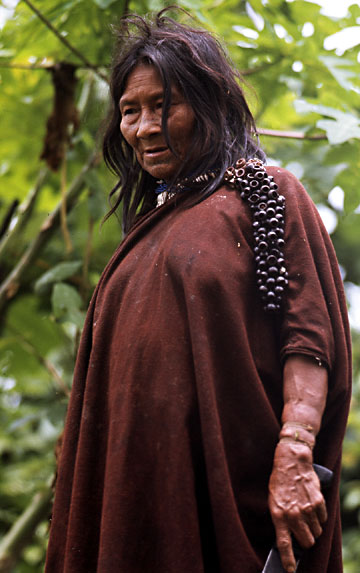 Traditionally, the Machiguenga believe in the divinity and sacredness of the
nature around them. They believe the forest is there to nurture them, its
plants, herbs, animals and fish, and that the earth is working in harmony to
sustain everything in the world. Their shamans are able to heal their people by
harnessing the qualities of local herbs, plants and minerals which they use to
manipulate animal spirits. Chief among their animistic practices is the
use of the plant ayahuasca to manipulate and control powerful jaguar spirits. Beyond the animistic
beliefs of the Machiguenga, their herbal lore
is a vast untapped resource that could help the world discover new cures and
medicines. Since
the 1960's, missionaries have moved into jungle
outposts close to the tribes. In many ways, the lives of the Machiguengas have been
totally transformed and turned up-side down. Some anthropologists believe
that new religion, new diseases, new value system, new ethics and new morality mean
that the old ways are dying rapidly. Critics say that these indigenous
Amazonians are no longer allowed to feel proud of their history, ancestry or
culture. Other anthropologists point out that indigenous cultures are adaptable
and are capable of adapting to a modern world, provided that core cultural
values and their native language remain intact. Traditionally, the Machiguenga believe in the divinity and sacredness of the
nature around them. They believe the forest is there to nurture them, its
plants, herbs, animals and fish, and that the earth is working in harmony to
sustain everything in the world. Their shamans are able to heal their people by
harnessing the qualities of local herbs, plants and minerals which they use to
manipulate animal spirits. Chief among their animistic practices is the
use of the plant ayahuasca to manipulate and control powerful jaguar spirits. Beyond the animistic
beliefs of the Machiguenga, their herbal lore
is a vast untapped resource that could help the world discover new cures and
medicines. Since
the 1960's, missionaries have moved into jungle
outposts close to the tribes. In many ways, the lives of the Machiguengas have been
totally transformed and turned up-side down. Some anthropologists believe
that new religion, new diseases, new value system, new ethics and new morality mean
that the old ways are dying rapidly. Critics say that these indigenous
Amazonians are no longer allowed to feel proud of their history, ancestry or
culture. Other anthropologists point out that indigenous cultures are adaptable
and are capable of adapting to a modern world, provided that core cultural
values and their native language remain intact.
Physically, the Machiguenga people resemble other indigenous Amazonians and tend to be short, strong and
slim with
broad, pleasant
facial features. They have little or no body hair and very little facial hair.
Typically, the hair on the head is dark black, coarse and very straight.
Generally, eye color is black or dark brown.
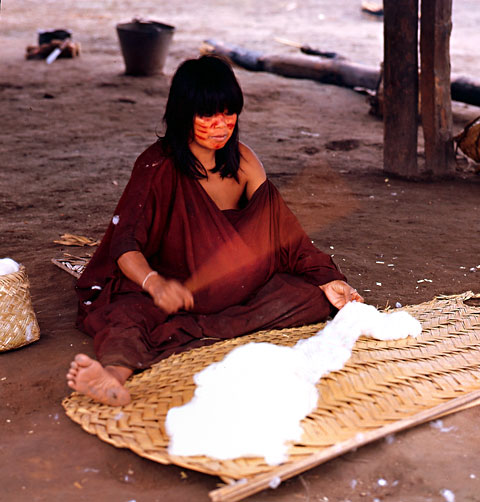 Traditionally,
the Machiguenga used to roam the Amazon Rainforest wearing little more than
beads (seeds and bones) and belts made of plant material. In addition,
they painted their bodies with colors obtained from plants, minerals and
charcoal. Tattoos, (both facial and body tattoos) are popular amongst men and
women. More recently, the Machiguenga have begun wearing "cushmas" which are tunics
woven from cotton. The Machiguenga traditionally cultivate cotton and weave
its fibers using a loom almost identical to the looms used in the Andes by
Quechua people. However, the Quechuans use wool or alpaca fibers, while
the Machiguenga always use cotton fibers. Traditionally,
the Machiguenga used to roam the Amazon Rainforest wearing little more than
beads (seeds and bones) and belts made of plant material. In addition,
they painted their bodies with colors obtained from plants, minerals and
charcoal. Tattoos, (both facial and body tattoos) are popular amongst men and
women. More recently, the Machiguenga have begun wearing "cushmas" which are tunics
woven from cotton. The Machiguenga traditionally cultivate cotton and weave
its fibers using a loom almost identical to the looms used in the Andes by
Quechua people. However, the Quechuans use wool or alpaca fibers, while
the Machiguenga always use cotton fibers.
Like most
indigenous Amazonians, the Machiguenga are traditionally nomadic, migrating from forest to forest on
a seasonal basis.
Once they exhausted the resources of a given area, they would move on in search
of new resources. Some anthropologists classify the
Machiguenga as hunter-gatherers who cultivate small swidden plots to
complement their meat intake. Their regular diet consisted of local rodents
(for example, "majas," Cuniculus paca), fish and cassava (Manihot
esculenta). However, other
anthropologists classify the Machiguenga as a civilized agrarian society in that
they have many characteristics that only advanced civilizations exhibit such as
weaving textiles, cultivating numerous food and fiber crops, and making
ceramics. Interestingly, a scientist studying the Machiguenga tribe (E.
Montgomery, "Towards representative energy data: the Machiguenga study.")
discovered that the Machiguenga, due to their hunter-gatherer lifestyle, expend
33% more calories than the normal American and that chronic physical diseases
such as diabetes and obesity did not exist in their Amazonian culture.
As to
their traditional family structure, the Machiguengas are often polygamous with one man
having several wives. However, some anthropologists have described the
Machiguenga tribe as matriarchal with the woman dominating the family. The
preferred marriage partner is a cross-cousin (i.e., the child of a
maternal uncle, or the child of paternal aunt). Newly married couples
prefer to live in the wife's home, so that the wife can receive the support of
her mother when she gives birth to her first child.
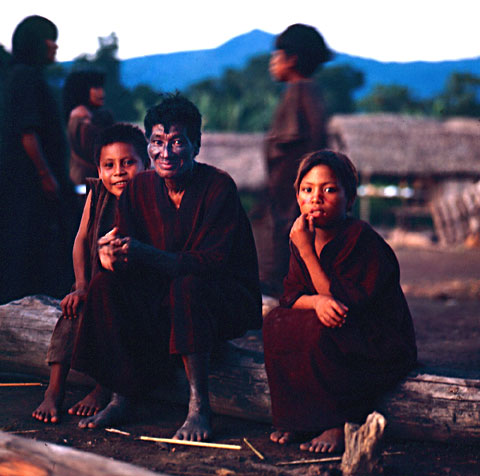 Recently,
the Machiguenga were the victims of a misguided television producer (Matt
Currington) and "fixer" (Deborah McLauchlan) who apparently caused a disease
epidemic among the Machiguenga tribe that killed eight people, including three
children. In their zeal to film "uncontacted Indians,"
Currington and Mc Lauchlan entered a restricted area in Manu National Park in
Peru that is home to a small group of Machiguenga Indians in the early stages of
making initial contact with the outside world. Passing themselves off as
"Discovery Channel producers," Currington and McLauchlan were really employed by
Cicada Productions from the United Kingdom, the actual producers of the
television series, "World’s Lost Tribes: Mark and Olly Living with the
Machigenga." The star of this series, Mark Anstice chose to bring his
"World’s Lost Tribes" television series to Peru after contacting the editor of
the Amazon-Indians.org website and the founder of the Movement in the Amazon for
Tribal Subsistence and Economic Sustainability (MATSES), Dr. Dan James Pantone.
Anstice claimed to be interested in helping the indigenous people of Peru and
discussed funding a vaccination program with Dr. Pantone, but the results of the
events that Anstice put into place speak much differently, resulting in the
deaths of indigenous Peruvians rather than their receiving benefits.
Although Currington and Cicada Productions were blacklisted by the Peruvian
government, Currington was not fired from his position nor punished for the
tragedy that he apparently caused. Incredibly, Currington continues to
work for Cicada producing television documentaries on indigenous people as if
nothing had happened. For an in depth assessment of the tragedy caused by
Currington and Mc Lauchlan, please refer to the
report ("An epidemic outbreak among the Matsiguenka in initial contact")
prepared for the Association of Social Anthropologists by doctoral candidate,
Daniel Rodriguez. Recently,
the Machiguenga were the victims of a misguided television producer (Matt
Currington) and "fixer" (Deborah McLauchlan) who apparently caused a disease
epidemic among the Machiguenga tribe that killed eight people, including three
children. In their zeal to film "uncontacted Indians,"
Currington and Mc Lauchlan entered a restricted area in Manu National Park in
Peru that is home to a small group of Machiguenga Indians in the early stages of
making initial contact with the outside world. Passing themselves off as
"Discovery Channel producers," Currington and McLauchlan were really employed by
Cicada Productions from the United Kingdom, the actual producers of the
television series, "World’s Lost Tribes: Mark and Olly Living with the
Machigenga." The star of this series, Mark Anstice chose to bring his
"World’s Lost Tribes" television series to Peru after contacting the editor of
the Amazon-Indians.org website and the founder of the Movement in the Amazon for
Tribal Subsistence and Economic Sustainability (MATSES), Dr. Dan James Pantone.
Anstice claimed to be interested in helping the indigenous people of Peru and
discussed funding a vaccination program with Dr. Pantone, but the results of the
events that Anstice put into place speak much differently, resulting in the
deaths of indigenous Peruvians rather than their receiving benefits.
Although Currington and Cicada Productions were blacklisted by the Peruvian
government, Currington was not fired from his position nor punished for the
tragedy that he apparently caused. Incredibly, Currington continues to
work for Cicada producing television documentaries on indigenous people as if
nothing had happened. For an in depth assessment of the tragedy caused by
Currington and Mc Lauchlan, please refer to the
report ("An epidemic outbreak among the Matsiguenka in initial contact")
prepared for the Association of Social Anthropologists by doctoral candidate,
Daniel Rodriguez.
Despite
abuses by outsiders such as Currington and Mc Lauchlan, the Machiguengas are renown for being non-violent and for their
warm reception of visitors. This is in contrast to some of the other
Amazonian tribes that live further downriver from the Machiguengas in the
lowland Amazon Rainforest. Surprisingly, the Machiguengas are relatively
easily accessible from the Machu Picchu area, living just downriver in the Upper
and Middle Urubamba River areas. However, few organized tours to the Machiguengas are
available and visitors must make arrangements on their own. If you would
like to learn how you can meet the Machiguenga Indians in person, please contact
info@amazon-indians.org.
The author, Ling Raj, is a British citizen of Indian descent who is presently
investigating the cultural similarities between Asian Indian and Amazonian
Indian ethnicities. The photographer, Chuck Clark, is an American from Victor,
Colorado. During the 1960's the Summer Institute of Linguistics (SIL) was
active in the Peruvian Amazon contacting indigenous Amazonians that were
previously living in isolation from Western cultures. Although he was not
a missionary, Clark worked as a photographer for SIL
at that time and recorded this historic period by photographing the "first
contact" of these indigenous people of the Amazon.
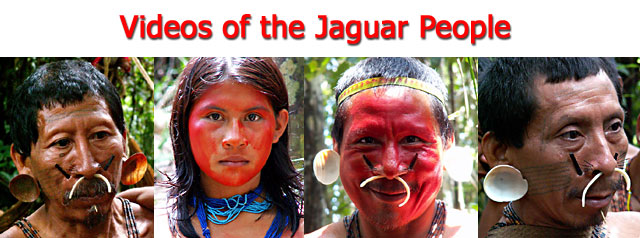
|

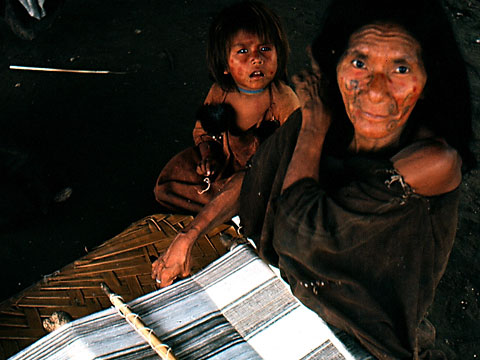
 The
Machiguenga are indigenous to the jungles of Southeastern Peru and the border region
of Peru with Bolivia and Brazil. Along with much of South America, their culture
was severely put under strain by the arrival of the Europeans. The Inca
Empire was located immediately to the west of the Machiguengas and when the
nearby Incas were defeated by the Spanish, some of the refugees fled to the
jungles inhabited by the Machiguengas and other Campas and most probably became
assimilated into these Amazonian cultures. Until the 1960's, most of the
Machiguenga lived isolated from Westerners due to their remote locations.
This changed when the Summer Institute of Linguistics (SIL) began flying in
American missionaries with small aircraft in the 1960's. However, due to the
impenetrable Amazon rainforest, some small groups of uncontacted Machiguengas
have survived to this day and remain living in voluntary isolation from Western
civilization. Recently loggers and miners have been
clearing new roads to infiltrate into the Amazon Rainforest inhabited by these
uncontacted groups of Machiguengas, putting their survival in jeopardy.
The
Machiguenga are indigenous to the jungles of Southeastern Peru and the border region
of Peru with Bolivia and Brazil. Along with much of South America, their culture
was severely put under strain by the arrival of the Europeans. The Inca
Empire was located immediately to the west of the Machiguengas and when the
nearby Incas were defeated by the Spanish, some of the refugees fled to the
jungles inhabited by the Machiguengas and other Campas and most probably became
assimilated into these Amazonian cultures. Until the 1960's, most of the
Machiguenga lived isolated from Westerners due to their remote locations.
This changed when the Summer Institute of Linguistics (SIL) began flying in
American missionaries with small aircraft in the 1960's. However, due to the
impenetrable Amazon rainforest, some small groups of uncontacted Machiguengas
have survived to this day and remain living in voluntary isolation from Western
civilization. Recently loggers and miners have been
clearing new roads to infiltrate into the Amazon Rainforest inhabited by these
uncontacted groups of Machiguengas, putting their survival in jeopardy.
 Traditionally, the Machiguenga believe in the divinity and sacredness of the
nature around them. They believe the forest is there to nurture them, its
plants, herbs, animals and fish, and that the earth is working in harmony to
sustain everything in the world. Their shamans are able to heal their people by
harnessing the qualities of local herbs, plants and minerals which they use to
manipulate animal spirits. Chief among their animistic practices is the
use of the plant ayahuasca to manipulate and control powerful jaguar spirits. Beyond the animistic
beliefs of the Machiguenga, their herbal lore
is a vast untapped resource that could help the world discover new cures and
medicines. Since
the 1960's, missionaries have moved into jungle
outposts close to the tribes. In many ways, the lives of the Machiguengas have been
totally transformed and turned up-side down. Some anthropologists believe
that new religion, new diseases, new value system, new ethics and new morality mean
that the old ways are dying rapidly. Critics say that these indigenous
Amazonians are no longer allowed to feel proud of their history, ancestry or
culture. Other anthropologists point out that indigenous cultures are adaptable
and are capable of adapting to a modern world, provided that core cultural
values and their native language remain intact.
Traditionally, the Machiguenga believe in the divinity and sacredness of the
nature around them. They believe the forest is there to nurture them, its
plants, herbs, animals and fish, and that the earth is working in harmony to
sustain everything in the world. Their shamans are able to heal their people by
harnessing the qualities of local herbs, plants and minerals which they use to
manipulate animal spirits. Chief among their animistic practices is the
use of the plant ayahuasca to manipulate and control powerful jaguar spirits. Beyond the animistic
beliefs of the Machiguenga, their herbal lore
is a vast untapped resource that could help the world discover new cures and
medicines. Since
the 1960's, missionaries have moved into jungle
outposts close to the tribes. In many ways, the lives of the Machiguengas have been
totally transformed and turned up-side down. Some anthropologists believe
that new religion, new diseases, new value system, new ethics and new morality mean
that the old ways are dying rapidly. Critics say that these indigenous
Amazonians are no longer allowed to feel proud of their history, ancestry or
culture. Other anthropologists point out that indigenous cultures are adaptable
and are capable of adapting to a modern world, provided that core cultural
values and their native language remain intact.
 Traditionally,
the Machiguenga used to roam the Amazon Rainforest wearing little more than
beads (seeds and bones) and belts made of plant material. In addition,
they painted their bodies with colors obtained from plants, minerals and
charcoal. Tattoos, (both facial and body tattoos) are popular amongst men and
women. More recently, the Machiguenga have begun wearing "cushmas" which are tunics
woven from cotton. The Machiguenga traditionally cultivate cotton and weave
its fibers using a loom almost identical to the looms used in the Andes by
Quechua people. However, the Quechuans use wool or alpaca fibers, while
the Machiguenga always use cotton fibers.
Traditionally,
the Machiguenga used to roam the Amazon Rainforest wearing little more than
beads (seeds and bones) and belts made of plant material. In addition,
they painted their bodies with colors obtained from plants, minerals and
charcoal. Tattoos, (both facial and body tattoos) are popular amongst men and
women. More recently, the Machiguenga have begun wearing "cushmas" which are tunics
woven from cotton. The Machiguenga traditionally cultivate cotton and weave
its fibers using a loom almost identical to the looms used in the Andes by
Quechua people. However, the Quechuans use wool or alpaca fibers, while
the Machiguenga always use cotton fibers.
 Recently,
the Machiguenga were the victims of a misguided television producer (Matt
Currington) and "fixer" (Deborah McLauchlan) who apparently caused a disease
epidemic among the Machiguenga tribe that killed eight people, including three
children. In their zeal to film "uncontacted Indians,"
Currington and Mc Lauchlan entered a restricted area in Manu National Park in
Peru that is home to a small group of Machiguenga Indians in the early stages of
making initial contact with the outside world. Passing themselves off as
"Discovery Channel producers," Currington and McLauchlan were really employed by
Cicada Productions from the United Kingdom, the actual producers of the
television series, "World’s Lost Tribes: Mark and Olly Living with the
Machigenga." The star of this series, Mark Anstice chose to bring his
"World’s Lost Tribes" television series to Peru after contacting the editor of
the Amazon-Indians.org website and the founder of the Movement in the Amazon for
Tribal Subsistence and Economic Sustainability (MATSES), Dr. Dan James Pantone.
Anstice claimed to be interested in helping the indigenous people of Peru and
discussed funding a vaccination program with Dr. Pantone, but the results of the
events that Anstice put into place speak much differently, resulting in the
deaths of indigenous Peruvians rather than their receiving benefits.
Although Currington and Cicada Productions were blacklisted by the Peruvian
government, Currington was not fired from his position nor punished for the
tragedy that he apparently caused. Incredibly, Currington continues to
work for Cicada producing television documentaries on indigenous people as if
nothing had happened. For an in depth assessment of the tragedy caused by
Currington and Mc Lauchlan, please refer to the
Recently,
the Machiguenga were the victims of a misguided television producer (Matt
Currington) and "fixer" (Deborah McLauchlan) who apparently caused a disease
epidemic among the Machiguenga tribe that killed eight people, including three
children. In their zeal to film "uncontacted Indians,"
Currington and Mc Lauchlan entered a restricted area in Manu National Park in
Peru that is home to a small group of Machiguenga Indians in the early stages of
making initial contact with the outside world. Passing themselves off as
"Discovery Channel producers," Currington and McLauchlan were really employed by
Cicada Productions from the United Kingdom, the actual producers of the
television series, "World’s Lost Tribes: Mark and Olly Living with the
Machigenga." The star of this series, Mark Anstice chose to bring his
"World’s Lost Tribes" television series to Peru after contacting the editor of
the Amazon-Indians.org website and the founder of the Movement in the Amazon for
Tribal Subsistence and Economic Sustainability (MATSES), Dr. Dan James Pantone.
Anstice claimed to be interested in helping the indigenous people of Peru and
discussed funding a vaccination program with Dr. Pantone, but the results of the
events that Anstice put into place speak much differently, resulting in the
deaths of indigenous Peruvians rather than their receiving benefits.
Although Currington and Cicada Productions were blacklisted by the Peruvian
government, Currington was not fired from his position nor punished for the
tragedy that he apparently caused. Incredibly, Currington continues to
work for Cicada producing television documentaries on indigenous people as if
nothing had happened. For an in depth assessment of the tragedy caused by
Currington and Mc Lauchlan, please refer to the
